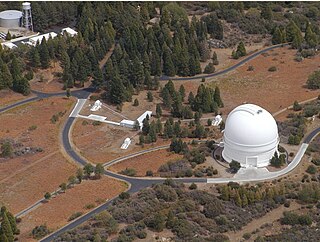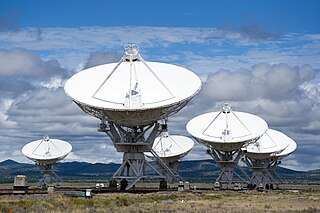Related Research Articles

Radio astronomy is a subfield of astronomy that studies celestial objects at radio frequencies. The first detection of radio waves from an astronomical object was in 1933, when Karl Jansky at Bell Telephone Laboratories reported radiation coming from the Milky Way. Subsequent observations have identified a number of different sources of radio emission. These include stars and galaxies, as well as entirely new classes of objects, such as radio galaxies, quasars, pulsars, and masers. The discovery of the cosmic microwave background radiation, regarded as evidence for the Big Bang theory, was made through radio astronomy.

Palomar Observatory is an astronomical research observatory in the Palomar Mountains of San Diego County, California, United States. It is owned and operated by the California Institute of Technology (Caltech). Research time at the observatory is granted to Caltech and its research partners, which include the Jet Propulsion Laboratory (JPL), Yale University, and the National Astronomical Observatories of China.
The National Geographic Society – Palomar Observatory Sky Survey was a major astronomical survey, that took almost 2,000 photographic plates of the night sky. It was conducted at Palomar Observatory, California, United States, and completed by the end of 1958.
The Digitized Sky Survey (DSS) is a digitized version of several photographic astronomical surveys of the night sky, produced by the Space Telescope Science Institute between 1983 and 2006.

The Wow! signal was a strong narrowband radio signal detected on August 15, 1977, by Ohio State University's Big Ear radio telescope in the United States, then used to support the search for extraterrestrial intelligence. The signal appeared to come from the direction of the constellation Sagittarius and bore expected hallmarks of extraterrestrial origin.
The Third Cambridge Catalogue of Radio Sources (3C) is an astronomical catalogue of celestial radio sources detected originally at 159 MHz, and subsequently at 178 MHz.
The Ohio State University Radio Observatory was a Kraus-type radio telescope located on the grounds of the Perkins Observatory at Ohio Wesleyan University in Delaware, Ohio from 1963 to 1998. Known as Big Ear, the observatory was part of Ohio State University's Search for Extraterrestrial Intelligence (SETI) project. The telescope was designed by John D. Kraus. Construction of the Big Ear began in 1956 and was completed in 1961, and it was finally turned on for the first time in 1963.

The Molonglo Observatory Synthesis Telescope (MOST) is a radio telescope operating at 843 MHz. It is operated by the School of Physics of the University of Sydney. The telescope is located in Hoskinstown, near the Molonglo River and Canberra, and was constructed by modification of the east–west arm of the former Molonglo Cross Telescope, a larger version of the Mills Cross Telescope. Construction of the original "Super Cross" telescope with 1.6-kilometre arms began in 1960 by Professor Bernard Y. Mills. It became operational in 1967.

The Fourth Cambridge Survey (4C) is an astronomical catalogue of celestial radio sources as measured at 178 MHz using the 4C Array. It was published in two parts, in 1965 and 1967, by the Radio Astronomy Group of the University of Cambridge. References to entries in this catalogue use the prefix 4C followed by the declination in degrees, followed by a period, and then followed by the source number on that declination strip, e.g. 4C-06.23.

An astronomical survey is a general map or image of a region of the sky that lacks a specific observational target. Alternatively, an astronomical survey may comprise a set of images, spectra, or other observations of objects that share a common type or feature. Surveys are often restricted to one band of the electromagnetic spectrum due to instrumental limitations, although multiwavelength surveys can be made by using multiple detectors, each sensitive to a different bandwidth.
The International Celestial Reference System (ICRS) is the current standard celestial reference system adopted by the International Astronomical Union (IAU). Its origin is at the barycenter of the Solar System, with axes that are intended to "show no global rotation with respect to a set of distant extragalactic objects". This fixed reference system differs from previous reference systems, which had been based on Catalogues of Fundamental Stars that had published the positions of stars based on direct "observations of [their] equatorial coordinates, right ascension and declination" and had adopted as "privileged axes ... the mean equator and the dynamical equinox" at a particular date and time.
The NRAO VLA Sky Survey (NVSS) was an astronomical survey of the Northern Hemisphere carried out by the Very Large Array (VLA) of the National Radio Astronomy Observatory (NRAO), resulting in an astronomical catalogue. It was led by James J. Condon.
John Daniel Kraus was an American physicist and electrical engineer known for his contributions to electromagnetics, radio astronomy, and antenna theory. His inventions included the helical antenna, the corner reflector antenna, and several other types of antennas. He designed the Big Ear radio telescope at Ohio State University, which was constructed mostly by a team of OSU students and was used to carry out the Ohio Sky Survey. Kraus held a number of patents and published widely.
The H I Parkes All Sky Survey (HIPASS) is a large survey for neutral atomic hydrogen (H I). Most of the data was taken between 1997 and 2002 using CSIRO's 64 m Parkes Telescope. HIPASS covered 71% of the sky and identified more than 5000 galaxies; the major galaxy catalogs are: the "HIPASS Bright Galaxy Catalog", the southern HIPASS catalog (HICAT), and the northern HIPASS catalog (NHICAT) Discoveries include over 5000 galaxies, the Leading Arm of the Magellanic Stream and a few gas clouds devoid of stars.
The Eridanus Group, sometimes called the Eridanus Cloud, is a nearby loose grouping of galaxies at a mean distance of approximately 75 Mly in the constellation Eridanus. Redshift values show that there are approximately 200 galaxies associated with the group, approximately 70% of which are spiral and irregular type galaxies while the remaining 30% are elliptical and lenticular types.

Faint Images of the Radio Sky at Twenty-Centimeters, or FIRST, was an astronomical survey of the Northern Hemisphere carried out by the Very Large Array. It was led by Robert H. Becker, Richard L. White, and David J. Helfand, who came up with the idea for the survey after they had completed the VLA Galactic Plane survey in 1990, as well as Michael D. Gregg and Sally A. Laurent-Muehleisen. The survey was started 50 years after the first systematic survey of the radio sky was completed by Grote Reber in April 1943.
TXS 0506+056 is a very high energy blazar – a quasar with a relativistic jet pointing directly towards Earth – of BL Lac-type. With a redshift of 0.3365 ± 0.0010, it has a luminosity distance of about 1.75 gigaparsecs. Its approximate location on the sky is off the left shoulder of the constellation Orion. Discovered as a radio source in 1983, the blazar has since been observed across the entire electromagnetic spectrum.
The Parkes Catalogue of Radio Sources, also known as the Parkes Southern Radio Source Catalog, consists of 8264 astronomical radio sources, mostly south of declination +27. The catalogue was mostly compiled by John Bolton and his colleagues for 20 years. Both the Molonglo 408-MHz survey and the 80-MHz Culgoora measurements of Slee et al have contributed to the usefulness of the catalogue. For now, the catalogue only contains sources originally found in the Parkes 2700-MHz survey. The catalogue contains radio sources that have a frequency range of 80 - 22,000 MHz.

The 40-foot radio telescope at Green Bank Observatory in the U.S. state of West Virginia was constructed in 1961, and started observing a selection of variable radio sources in the same year, completing its observations in 1968. It became the first automated telescope in 1962. It was subsequently used during summer schools, and in 1987 it was repurposed as an educational telescope, as well as continuing to observe radio sources. In 2021 the telescope celebrated its sixtieth anniversary, having been in continuous use since its 1987 restoration, and used by more than 1,500 students.
References
- ↑ Kraus, John D. (1977). "The Ohio Sky Survey and other radio surveys". Vistas in Astronomy. 20 (3): 445–474. Bibcode:1977VA.....20..445K. doi:10.1016/0083-6656(77)90027-7.
- ↑ Scheer, D. J.; Kraus, J. D. (1967). "A High-Sensitivity Survey of the North Galactic Polar Region at 1415 MHz". The Astronomical Journal. 72 (4): 536. Bibcode:1967AJ.....72..536S. doi: 10.1086/110263 .
- ↑ Dixon, R. S.; Kraus, J. D. (1968). "A High-Sensitivity 1415 MHz Survey at North Declinations between 19 and 37 degrees". The Astronomical Journal. 73: 381. Bibcode:1968AJ.....73..381D. doi:10.1086/110642.
- ↑ Kraus, J. D.; Dixon, R. S.; Ehman, J. R. (1973). "The Ohio Survey – Status and Results". Bulletin of the American Astronomical Society. 5: 319. Bibcode:1973BAAS....5..319K.